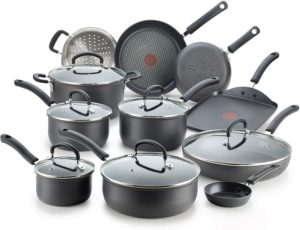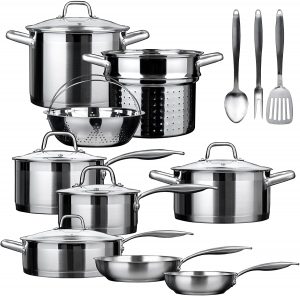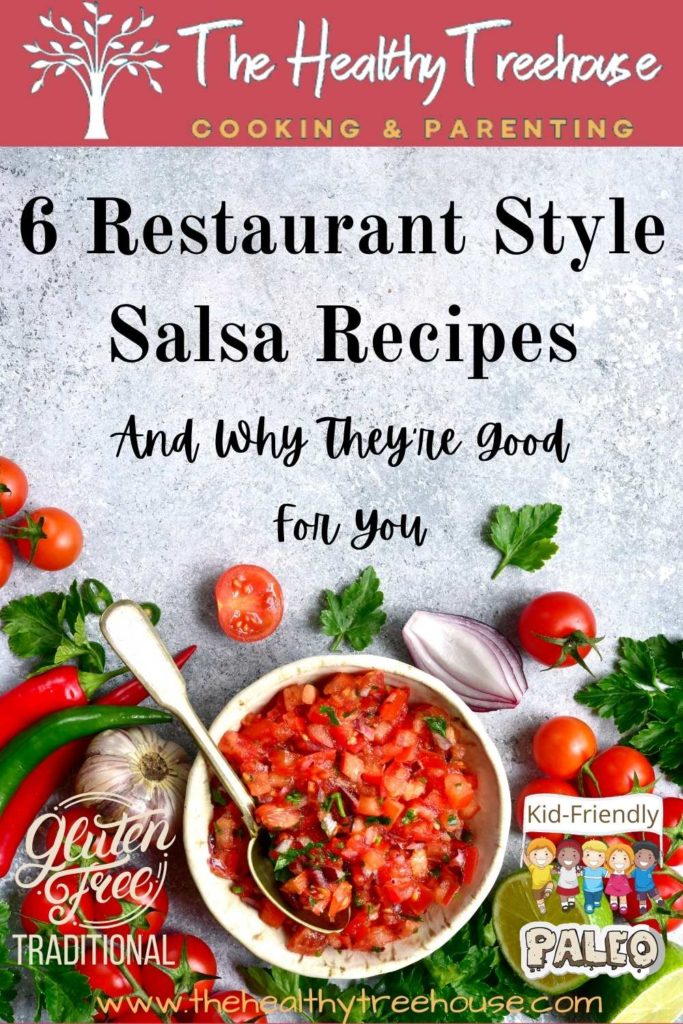
Restaurant-style salsa, such as the famous The Pioneer Woman salsa adaptation, might seem impossible to replicate, but we were pleasantly surprised to discover some secrets that made making healthy homemade salsa as easy as saying olé!
Salsa, that lovable fiery Mexican dip that goes great with so many crunchy foods, is surprisingly easy to make once you know how, and we’re about to give you the inside scoop.
Below are some of the best restaurant style salsa recipes along with some choice reasons why you need more salsa in your diet.
Recipes that we cover in this article are:
- Gluten-Free Tomato Salsa Recipe
- Non-Spicy Kid-Friendly Salsa
- Authentic Salsa Roja
- Avocado Salsa Verde
- Restaurant Style Blender Salsa Recipe
- Best Blender Salsa Recipe in 5 Minutes
We also wanted to be sure you had healthy “chip” options for dipping into your salsa.
After all, what is a dip with no chips?

Restaurant-Style Salsa Recipes
Each of these versions is extremely easy to make and packs a unique punch.
Gluten-Free Tomato Salsa Recipe
This a version that’s easy to make, and it’s completely gluten-free salsa!
For store-bought and pre-made salsas, you will want to read the ingredient list to double-check that the salsa is indeed gluten-free.
Gluten is a mix of proteins found in certain natural ingredients, such as rye, wheat, and barley.
While some people are straight-up allergic to this stuff, others prefer to keep it out of their diet to maintain health.
Some of the side effects of this component include mild symptoms such as diarrhea, fatigue, constipation, and bloating.
It can also include harsher symptoms, such as unexpected weight loss, intestinal damage, and even malnutrition.
We don’t have to worry about that with this recipe, but is salsa gluten free naturally?
No, it is not.
Some salsa recipes can contain vinegar, which may have been distilled with grains that contain gluten, revoking its gluten-free status.
This is why we’ve opted to provide a gluten-free salsa version—no one should have to go without eating this yummy dish!
To get the dish just right, you should prepare the tomatoes in a special way.
This includes boiling them for a minute before immersing them in iced water for an additional two minutes.
These blanching and shocking step make it extremely easy to peel your tomatoes, thereby resulting in a pulpier and tastier sauce.
To make this batch all the more worthwhile, we suggest pairing it with homemade gluten-free tortilla chips, which are surprisingly easy to make.
Simply slice some gluten-free corn tortillas into 6 wedges, spray with cooking spray and sprinkle with salt, and bake at 350 until golden and crispy!
If you have a gluten sensitivity, or just avoid grains in your diet, this salsa will be your perfect chip accompaniment.

Non-Spicy Kid-Friendly Salsa
Some salsa recipes can be a bit overwhelming for some children, so it’s important to make a bare-bones version.
For this, you can keep things really simple and sweet, using nothing more than fresh tomatoes, salt, lime juice, and green bell pepper.
Based on your child’s taste buds, you can even venture as far as using additional ingredients, such as red onion and cilantro.
You don’t need anything more than this when you’re making a kid-friendly version. It may lack a certain zest, but it will still be plenty flavorful.
Those who are sensitive to heat and spice will enjoy this salsa – it’s not just for kids!

Authentic Salsa Roja
This is a highly authentic version that deviates a fair amount from the others, especially the ones featured in The Pioneer Woman.
For instance, it’s important to use plum tomatoes for this version as they’re often considered to be the best tomatoes for salsa.
The other magic ingredients here are onion, cilantro, jalapeno and serrano peppers.
It’s also crucial that you opt for fresh plum tomatoes instead of their canned cousins—this factor alone can make a huge difference in the taste and consistency of your homemade version.
A good rule of thumb while making this dish is to use fresh ingredients whenever possible.
One last crucial factor in retaining the unique flavoring of this recipe is to avoid lemon juice entirely!
Yes, you heard us right, no lemons, por favor!
This tangy fruit tends to be the balancing agent for most dishes, but when it comes to this version of salsa, we urge you to drop it entirely as it throws off the flavor balance.
When looking for an authentic, restaurant-quality salsa, this salsa recipe pairs perfectly with chips, veggies, tacos, nachos, or any other south-of-the-border inspired meal.

Avocado Salsa Verde
Salsa verde is traditionally a green salsa, made with green tomatoes or tomatillos.
Contrary to popular belief, tomatillos are not green tomatoes, but their own fruit, which originated in Mexico.
They come with a papery skin that must be removed before using.
Salsa verde usually contains jalapeno, lime, cilantro, onion or garlic, all blended with tomatillos until smooth.
We love this recipe because it is a hybrid salsa verde and guacamole dip, due to the addition of creamy avocado.
You’ll love this recipe if you want fresh salsa in only 10 minutes, are a fan of salsa verde, and also love the flavors of guacamole.

Restaurant Style Blender Salsa Recipe
When grabbing a quick bite at a Mexican restaurant, you will probably come across this very salsa.
This salsa is all about using pantry staple ingredients, such as canned whole tomatoes and diced tomatoes with green chilis, which add a surprising kick.
When using canned tomatoes, some recipes will call for a pinch of sugar in the salsa, to combat any tartness from the tomatoes.
Ground cumin and fresh cilantro make this salsa flavorful, and the blender makes the recipe a cinch to prepare.
This salsa is for you if you enjoy a smokier salsa, due to the addition of the cumin.

Best Blender Salsa Recipe in 5 minutes!
Almost all salsas can be prepared in the blender, depending on how chunky you like your ingredients.
Using fresh tomatoes over canned gives this salsa a wonderful tartness without being overpowering.
Plus, canned ingredients such as tomatoes or jalapenos can often give a canned or “tin-like” flavor, so using all fresh components for this salsa makes a huge difference in taste and texture.
Of the lot, this recipe is the quickest at less than 5 minutes preparation time.
Choose to make this salsa if you want a lazy-day snack with maximum freshness and flavor.
And, you can use this salsa to top anything, from chicken to salads to baked potatoes.
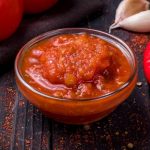
What to Eat With Your Homemade Salsas
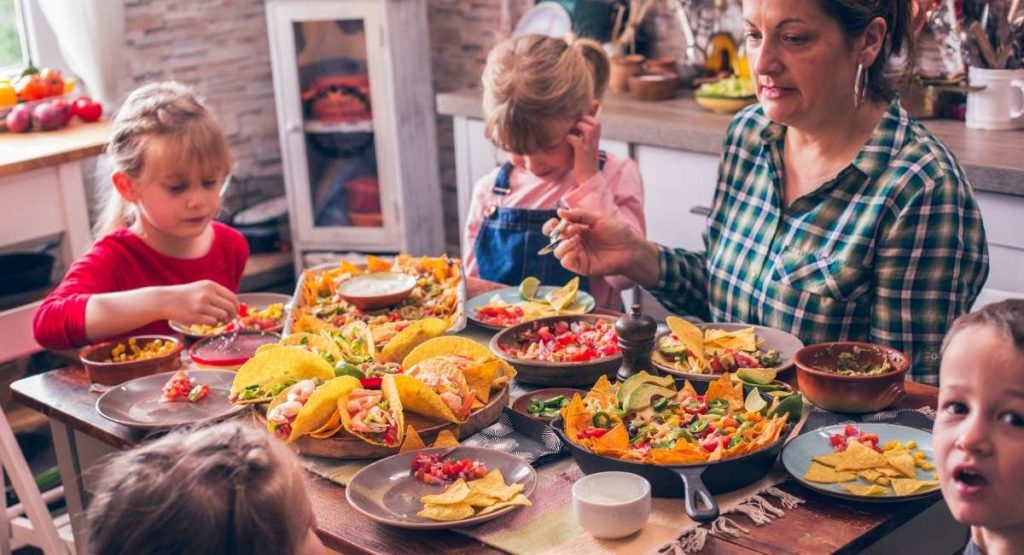
Deciding what crunchy snack to dip into your homemade salsa is half the battle.
The most obvious choice for a lot of people are tortilla chips, either homemade or store-bought.
Tortilla chips are deep-fried and sliced tortillas that add a satisfying crunch to your zesty, tomato-based dip.
If you are looking for a gluten-free chip option that is not primarily corn-based, then I recommend these lentil chips.
While chips (of any kind) are tasty, they are certainly not the healthiest option when choosing a vessel in which to eat salsa.
The Rainbow Perspective, or Phytonutrient Spectrum Foods are a great reference for choosing healthy snacks – phytonutrients highlight the nutritional benefits of fresh produce based on their rainbow spectrum of colors.
Here are some delicious, healthy options to dip into your restaurant style salsa.
Celery
Celery is an excellent, crunchy green vegetable that many love to snack on.
Typically, you’ll see folks adding peanut butter, raisins, or cream cheese atop celery for a healthy snack, commonly referred to as “Ants on a Log.”
Why not add salsa to this healthy veggie’s repertoire?
Simply top the concave part of the celery with your fresh restaurant salsa recipe, or dip the veggie straight in.
Made mostly of water, celery contains approximately 25 anti-inflammatory compounds that fight inflammation in the body.
And, celery is so crunchy, you won’t miss the chips!
This vegetable is green, therefore the phytonutrient benefits are increased brain health, anti-cancer, anti-inflammatory, skin health and cell protection.
Bell Peppers
Quartered or sliced bell peppers mimic the shape of a chip, and also display a delicious, vegetal crunch to any crudite platter.
You can use any color bell pepper that you enjoy, whether it is red, green, yellow, orange, or purple.
All colors of bell peppers have gastrointestinal benefits and heart health benefits, based on the phytonutrient spectrum.
They contain high amounts of vitamin A, vitamin C, vitamin B6, dietary fiber, potassium, and folate.
Mini sweet bell peppers are scrumptious options as well, as those can be halved and stuffed with salsa for an easy party appetizer.
The sweetness that bell peppers bring to the table plays so nicely with the zesty spiciness of salsa, while still displaying a satisfying crunch.
Cucumbers
As one of the tastiest healthy snacks, cucumbers make for a delicious “chip” in which to dip into salsa.
Cucumbers contain tons of antioxidants, which help your body fight disease, and contain 62% of your daily recommended vitamin K in one serving.
Cut thicker cucumber slices to top with salsa on an appetizer platter, or cut slightly thinner slices in order to dip right into the salsa bowl.
Cucumbers contain lots of moisture, so be sure to freshly cut your cucumber upon snacking to prevent significant moisture loss.
Green cucumbers offer hormone balance, cell protection, and improve liver health based on their phytonutrients.
Carrots
Carrots happen to be ranch dressing’s best friend, and it’s time they begin a new friendship with salsa.
Carrots are high in beta-carotene, which your body converts into vitamin A, and then helps aid in eye health; lowering your risk of cataracts and other eye problems.
We find that slicing whole carrots on the bias about ¼-inch thick makes for large, crunchy “chips” for your salsa dip.
Your local grocery store may also sell crinkle-cut carrot chips in the produce aisle by the baby carrots, which work great for dipping into salsa.
On the color spectrum, orange foods offer immunity, reproductive health, and an excellent source of vitamin A.
Jicama
Jicama is a root vegetable that may not be on everyone’s radar.
It is a native mexican vine, in which the crunchy root is consumed by itself or with many other fresh foods.
The consistency is similar to a water chestnut, however jicama is ultra-crunchy and contains a lot of water content.
Eating jicama promotes healthy digestion and weight loss, as it is packed with fiber and vitamin C.
This vegetable is very mild in flavor, lending a nice balance to salsa.
Although jicama is not a brightly colored vegetable, the phytonutrient spectrum of white/tan produce offers heart, liver, and gastrointestinal benefits, as well as improving anti-inflammatory health.
Kale Chips
Dark, leafy greens are some of the most nutrient-dense foods from our Mother Earth.
Sure, you can buy mass-produced kale chips from the store, but will you be able to pronounce all the ingredients listed on the package?
Probably not.
Making your own healthy baked kale chips for salsa is simple.
Toss stemmed and trimmed kale with a light oil and some salt before roasting in a hot oven for 5-10 minutes.
The result is a crunchy chip that parallels tortilla chips, however green kale promotes cell protection, and contains vitamin K, vitamin C, and powerful antioxidants that help lower cholesterol and reduce the risk of heart complications.
Good luck finding a chip with comparable health benefits to kale!
Eggs
While eggs are the least crunchy of all salsa accompaniments, they might be the tastiest.
Topping simple scrambled eggs with salsa is a delicious and nutritious breakfast or lunch, and immediately turns boring eggs into a flavorful scramble.
Eggs are a notable source of high-quality protein and vitamin B12, giving you energy and lasting power throughout the day.
You can’t dip your eggs into salsa unfortunately, but topping any cooked eggs with salsa is like an unexpected match made in heaven.
Shrimp Cocktail
The most obvious pairing to shrimp cocktails is cocktail sauce, right?
Wrong!
Although both are tomato-based sauces, salsa pairs extremely well with delicately poached whole shrimp.
Lots of healthy grocery stores sell great-quality frozen cooked shrimp that simply needs to thaw before eating.
Shrimp is high in protein and may help promote brain and heart health.
While shrimp is not crunchy, it is a delicious, meaty snack that pairs so well with the flavors of any salsa.

Is Salsa Healthy? The 8 Reasons Why Eating Salsa Is Healthy
Do we really need a reason to consume this delectable dip?
We’d like to think not, but for all you non-believers, we have some crucial reasons why consuming this dynamite dish could be great for your health.
Check Out That Nutritional Profile!
Despite being a low-caloric affair, this dip is power-packed with vitamins and minerals.
Just look at these awesome stats for 100 grams:
- Calories: 18
- Carbohydrates: 4g
- Fiber: 1.2g
- Fat: 0.2g
- Saturated fat: 0.0g
- Sugar: 6g
- Protein: 0.8g
It’s clear that this dish is low in fat and has plenty of vitamins and minerals.
Here’s its vitamin breakdown for every 100 grams:
- Vitamin A: 779.2IU
- Folate: 14.2mcg
- Vitamin C: 17.8mg
- Choline: 11.7mg
As we can see, this dish is a regular cocktail of various vitamins, and it can work wonders on your system.
It’s also worth looking at the mineral profile of the dip every for 100 grams:
- Sodium: 198.6mg
- Potassium: 215.4mg
- Calcium: 11.4mg
- Magnesium: 10.2mg
Vitamin C is Crucial
Thanks to the fact that this dish is near impossible to make without a healthy dose of tomatoes, it tends to be packed with vitamin C.
This is one of the most vital vitamins, as it helps your body produce and repair blood vessels, skin, teeth and collagen.
It’s also been proven that the antioxidant properties of vitamin C help reduce oxidative stress levels and reduce free radical damage.
Oxidative stress is caused due to the imbalance of antioxidants and free radicals in your system.
During your normal metabolic process, the body produces a certain volume of free radicals and antioxidants, which counter the free radicals.
When the amount of free radicals is greater than the antioxidants, it can lead to something quite terrifying—accelerated aging!
This can occur due to the following reasons:
- Lifestyle
- Diet
- Environmental conditions, such as radiation or excessive pollution
Thus, consuming vitamin C can help keep these levels in check and allow you to age as you normally would.
Powered by Lycopene
If you haven’t heard of lycopene, it’s a carotenoid compound that can be found in a select set of fruits such as grapefruit, and… that’s right… tomatoes!
This mystery compound has been proven to contain tons of nutritional benefits, such as:
- Lowering your risk of prostate cancer
- Decreasing risk of contracting cardiovascular diseases
- Improving your UV resistance
- Reducing the risk of metabolic syndrome
All this from a compound you (probably) just heard about for the first time!
The best part is that lycopene is more bioavailable when you consume tomatoes in cooked form, and some of the recipes are better when starting with a tomato paste.
The Fiber In Your Diet
Everyone needs some fiber in their diet, and salsa offers you a decent version of it.
It contains all the benefits of fiber without the damaging side effects of fat or sugar that usually accompanies high-fiber ingredients, such as with avocados or carrots.
This allows individuals with type 2 diabetes, in particular, to add some flavoring in their meals without having to stress about their sugar levels.
Consuming high-fiber foods also helps us feel satiated without spiking insulin levels.
Feel the Burn (In More Ways Than One)
So far, tomatoes have pretty much been the highlight of this show, but this dish has some other secrets up its sleeve.
Jalapenos, for example, are commonly used in making salsa, and they not only add some much-needed zest to the flavor, but it turns out they can also help you burn some fat!
These spicy veggies contain a compound known as capsaicin, and recent studies have shown that it can help boost your metabolic rate and also lower your blood sugar levels.
Drop the Blood Pressure
The American diet, in particular, is dangerously low on potassium. Luckily, salsa can once again step in here.
It’s rich in this vital mineral, containing 3% of the DV (every 100 gms), thereby allowing you to better regulate your mineral balance, fluid balance and blood pressure.
Gluten and Paleo-Friendly
As you can probably tell by now, this dish is versatile in its benefits.
Not only does it fit perfectly with a gluten-free diet (unless it contains white vinegar), but it’s also compatible with the paleo diet, is kid-friendly and is a perfectly balanced traditional dish.
You can also work this sauce into your meal planning since it mixes well with so many foods and can be stored safely for up to a week.
To Top It All Off…
Besides this impressive list of benefits, this magic sauce can also offer you improved hydration—thanks to the fact that tomatoes are 95% water—provides quercetin—another anti-inflammatory compound found in tomatoes—and is also cholesterol-free!
So the answer to the question if salsa is healthy, is a resounding yes!

Your Salsa FAQs Answered
Does Salsa Freeze Well?
Your favorite homemade salsa recipe is perfectly fine to freeze, as the texture will not change from the freezing stage to the defrosting stage.
Salsa will last in its best form for up to two months in the freezer.
The sauce will last longer than two months while freezing, however that is the optimal time to consume your salsa after frozen.
What Containers Are Good For Storing Salsa?
If you are not freezing your salsa, the sauce will last for about 1 week in the fridge in an airtight container.
The best way to ensure longevity and prevent spoilage is to properly store your salsa using sterilized mason jars and lids.
This is the best storage option, especially if you plan on making your salsa recipe in bulk.
Begin by setting your open mason jars in a large boiling pot, filling with enough water to cover the jars.
You will also want to boil both parts of the jar lids.
Once boiling, carefully remove your jars, draining them of any water, and setting aside to air dry.
Fill your hot jars with your homemade salsa, leaving ¼-inch space from the top.
Secure carefully with your hot lids and place your filled jars back into the boiling water until a seal has been created.
Remove from the water and allow to cool completely before storing in the cupboard or freezing.
Does Spicy Food Hurt Your Taste Buds?
Ultra spicy food has a reputation of being a taste-bud killer, as the spicy chemical capsaicin temporarily causes heat and numbness when eating.
The numbness gives off the impression that your taste buds are dying due to the heat and potential uncomfortability of spicy food.
Experts say they aren’t.
Your mouth’s numbness is a physical reaction to the heat that your body experiences to protect itself from the spice.
As all cells in our bodies diminish as we age, some believe that this is due to eating very spicy food.
This is another common misconception; all cells diminish with age, including our taste buds, and it does not matter how much spicy food was consumed along the way.
Can Too Much Spice Hurt Your Health?
Too much spice may cause some heartburn or indigestion, or trigger abdominal pain in some people.
Nutritionists agree that while spicy food does not cause gastrointestinal issues, consuming it may aggravate these problems in people with sensitive stomachs.
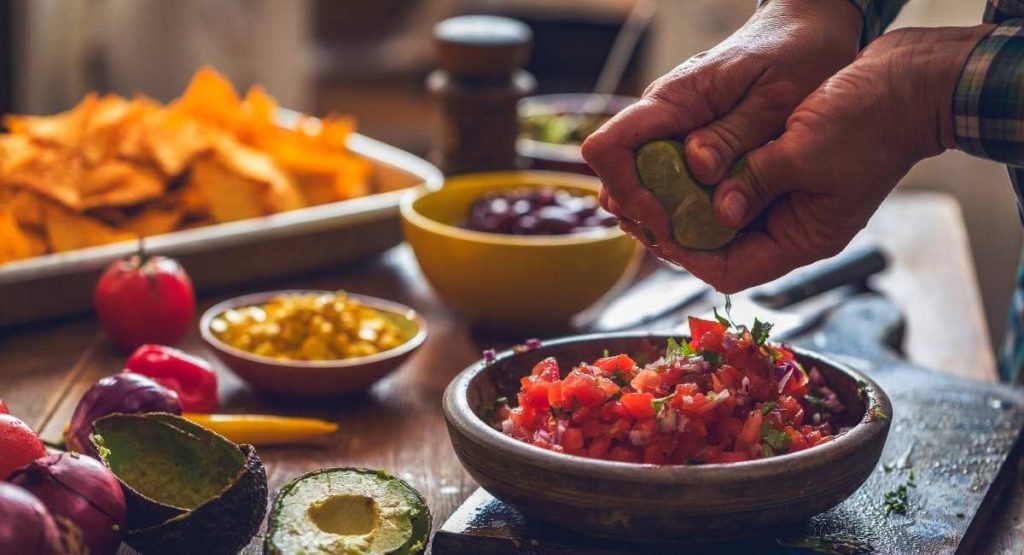
What Makes Something a Salsa?
For something to be a salsa, the dish must consist of a fine tomato base, flavored with spicy, sweet and tangy agents.
It must also be a dip or a sauce.
What food goes well with salsa?
Have some leftover bagels at home? Don’t throw them away!
These gluten-free bagels can be quickly tossed back in the oven with some salsa and cheese on top.
Add some basil and olive oil for that Margherita pizza experience.
These chicken breasts can be paired with different sauces, but a scrumptious salsa is the best one to serve it with.
Finish with a fresh garden salad and you’ve got a complete meal!
Who says homemade fish fillets are only meant for white dipping sauces?
Well, even though they pair well with creamy dips and dressings, they taste just as irresistible when you serve it with some tomato-based sauce like this salsa!
Nothing beats salsa when paired with these crispy baked parmesan chicken strips.
Imagine the crunch, cheesiness, and umami flavor this recipe will provide.
Then, dip it in some sweet and tangy salsa.
The mixture of flavors, different textures, outstanding mouthfeel and taste – what more could you ask for?
Tools to Help With Making Salsa
Some home cooks may prefer to meticulously slice and dice all of the salsa ingredients and mix, much like a standard pico de gallo.
If you are into utilizing time-saving appliances, a food processor or blender can help you make a salsa with the perfect consistency.
The Nutribullet Blender Combo is one of the best blenders for making homemade, delicious salsa.
The appliance comes with a 64 oz. pitcher for blending large amounts of salsa, and also comes with 32 oz. and 24 oz. blender cups, which you can use for smaller amounts of salsa.
The smaller cups also come with airtight lids, should you want to store your salsa in the fridge, right in the blender container.
The three blending speeds on this machine help determine the final consistency of the salsa, whether you like your salsa chunky or silky-smooth.
Why not take some help from your blender and save your knife skills for another time?
The Taste of Cancun
Preparing salsa at home can be a true delight for fans of the culinary arts.
Although tortillas are its natural partner, salsa goes well with pretty much anything salty, crunchy or meaty.
It’s an accommodating dish that allows plenty of room for experimentation and personalization.
You’ll know this to be true from the diversity in the recipes we’ve covered—from The Pioneer Woman salsa recipe to gluten-free versions, all of which are delicious and healthy salsa recipes.
The pièce de résistance of this recipe is that it’s packed with various nutritional benefits that will benefit your body in multiple ways.
And knowing how to make salsa with an at-home appliance is a time-saving option for those who like to spend most of their free time outside the kitchen.



